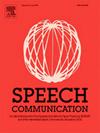Deep learning based stage-wise two-dimensional speaker localization with large ad-hoc microphone arrays
IF 2.4
3区 计算机科学
Q2 ACOUSTICS
引用次数: 0
Abstract
While deep-learning-based speaker localization has shown advantages in challenging acoustic environments, it often yields only direction-of-arrival (DOA) cues rather than precise two-dimensional (2D) coordinates. To address this, we propose a novel deep-learning-based 2D speaker localization method leveraging ad-hoc microphone arrays. Specifically, each ad-hoc array comprises randomly distributed microphone nodes, each of which is equipped with a traditional array. Our approach first employs convolutional neural networks at each node to estimate speaker directions.Then, we integrate these DOA estimates using triangulation and clustering techniques to get 2D speaker locations. To further boost the estimation accuracy, we introduce a node selection algorithm that strategically filters the most reliable nodes. Extensive experiments on both simulated and real-world data demonstrate that our approach significantly outperforms conventional methods. The proposed node selection further refines performance. The real-world dataset in the experiment, named Libri-adhoc-node10 which is a newly recorded data described for the first time in this paper, is online available at https://github.com/Liu-sp/Libri-adhoc-nodes10.
基于深度学习的舞台二维扬声器定位与大型特设麦克风阵列
虽然基于深度学习的说话者定位在具有挑战性的声学环境中显示出优势,但它通常只产生到达方向(DOA)线索,而不是精确的二维(2D)坐标。为了解决这个问题,我们提出了一种新的基于深度学习的2D扬声器定位方法,利用特设麦克风阵列。具体来说,每个自组织阵列由随机分布的麦克风节点组成,每个节点配备一个传统阵列。我们的方法首先在每个节点上使用卷积神经网络来估计说话人的方向。然后,我们使用三角测量和聚类技术对这些DOA估计进行整合,以获得2D扬声器位置。为了进一步提高估计精度,我们引入了一种节点选择算法,该算法战略性地过滤最可靠的节点。在模拟和现实世界数据上进行的大量实验表明,我们的方法明显优于传统方法。提出的节点选择进一步改进了性能。实验中的真实数据集名为lib -adhoc-node10,这是本文首次描述的新记录数据,可在https://github.com/Liu-sp/Libri-adhoc-nodes10上在线获取。
本文章由计算机程序翻译,如有差异,请以英文原文为准。
求助全文
约1分钟内获得全文
求助全文
来源期刊

Speech Communication
工程技术-计算机:跨学科应用
CiteScore
6.80
自引率
6.20%
发文量
94
审稿时长
19.2 weeks
期刊介绍:
Speech Communication is an interdisciplinary journal whose primary objective is to fulfil the need for the rapid dissemination and thorough discussion of basic and applied research results.
The journal''s primary objectives are:
• to present a forum for the advancement of human and human-machine speech communication science;
• to stimulate cross-fertilization between different fields of this domain;
• to contribute towards the rapid and wide diffusion of scientifically sound contributions in this domain.
 求助内容:
求助内容: 应助结果提醒方式:
应助结果提醒方式:


